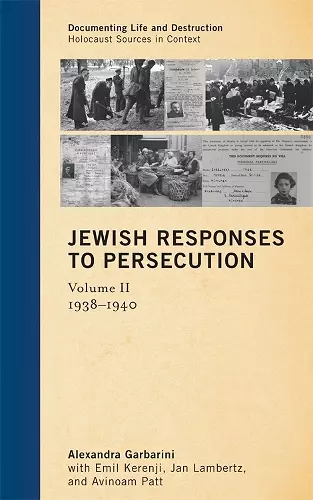Jewish Responses to Persecution
1938–1940
Emil Kerenji author Alexandra Garbarini author Jan Lambertz author Avinoam Patt author
Format:Hardback
Publisher:AltaMira Press
Published:15th Sep '11
Currently unavailable, and unfortunately no date known when it will be back

Jewish Responses to Persecution: Volume II, 1938–1940 is the second volume of the five-volume set within the series "Documenting Life and Destruction: Holocaust Sources in Context." This volume brings together in an accessible historical narrative a broad range of documents—including diaries, letters, speeches, newspaper articles, reports, Jewish identity cards, and personal photographs—from Jews in Nazi-dominated Europe and beyond Europe's borders. The volume skillfully illuminates the daily lives of a diverse range of Jews who suffered under Nazism, their coping strategies, and their efforts to assess the implications for the present and future of the persecution they faced during this period. Volume II begins with Kristallnacht in 1938 and continues through the Jewish flight out of Germany, the onset of World War II, the forced relocation of the Jews of Europe to the East, and the formation of Jewish ghettos, particularly in Poland. The twelve chapters, divided into four parts, track the trajectory of German expansion and anti-Jewish policies chronologically, attesting to a clear progression of persecution over time and space. At the same time, they reflect the vast differences in the responses of Jewish communities, groups, and individuals within and beyond the Germans' grasp, differences that resulted both from the unevenness of the Reich's policy toward Jews as well as the varied backgrounds, traditions, expectations, and life histories of Jews affected by German policy. This volume raises essential questions, such as: What was the spectrum of Jewish perceptions and actions under Nazi domination? How did Jews affected directly, or others standing on the outside, view the situation? In what ways were Jews able to influence their own fate under persecution? What role did Jewish tradition play in how the present and future were interpreted? The answers inherent in the documents are often varied or inconclusive; nonetheless these sources add considerably to our understanding of the Holocaust.
This impressive series provides a sense of the depth and diversity of contemporary Jewish documents while embedding them in explanatory narratives. . . . Documents in Volume II focus on broad questions of daily life and explore their social, economic, cultural, and religious aspects during the critical period between late 1938 and the end of 1940. . . . Even as [the editors] emphasize that the Jewish history of these years is best studied as transnational history, the ‘geographic heart’ of their volume rests explicitly in Poland. As the editors assert, on the one hand this simply reflects their reading of contemporary sources, which tend recurrently to draw attention to the plight of Polish Jewry. On the other, this emphasis is also meant to stress — as did contemporary commentators — how ‘unprecedented’ the nature of Nazi actions in Poland was even prior to the launching of comprehensive genocide. * Yad Vashem Studies *
This second volume of the series, Jewish Responses to Persecution, 1933–1946, that covers the period 1938 to 1940, will be of immense importance both to historians and to general readers alike. As in the preceding volume, the Jewish victims' reactions to the rapidly expanding Nazi onslaught are contextualized in an exemplary presentation: an admirable addition to an essential initiative. -- Saul Friedländer, University of California at Los Angeles
This is an excellent piece of work. It presents a far more varied and complex picture of Jewish responses during the period in question than is available from any existing documentary anthology or textbook. The authors are to be congratulated. -- David Engel, New York University
An outstanding book. The combination of documents and integrating narrative makes for a riveting read as well as a crucial teaching text. The chapters offer a kaleidoscope of views, sensitively contextualized, on a key period in the history of the Holocaust. -- Mark Roseman, Indiana University at Bloomington
ISBN: 9780759120396
Dimensions: 239mm x 162mm x 41mm
Weight: 1093g
612 pages